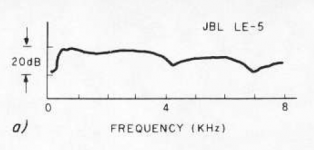Give it a try but note that the throat size was based on the dia of the surround for the 5MR450NDY. Use the Volvotreter spreadsheet for tractrix design and make your own flare for the Visaton.
I do now the spreadsheet from volvotreter but is that not the round one? like on the old recordplayers with that big needle
you have a version with two straight panels and one exp/tractrix flare.
Yes I do now what you mean with a other throat, May I ask why there are two 5MR450 in the akabak script? one for 8 and one for 4 ohms, I presume one will be used.
For some intent the faults who talk people here about, I agree that a horn has to be sound right without DSP processing, I do not like processing at all, Ik go try to simulate
and see what it does, I think the synergy form is a other matter because of the horn on that horn like mention here.
Thanks for your help
kees
Last edited:
Look for the tab that lets you calculate based on throat dimensions.
http://volvotreter.de/downloads/Tractrix_v1.4b.zip
I have both 4 ohm and 8 ohm defined in the preamble but only use one of them in the driver element line further down.
http://volvotreter.de/downloads/Tractrix_v1.4b.zip
I have both 4 ohm and 8 ohm defined in the preamble but only use one of them in the driver element line further down.
The distortion at the SPL levels that xrk971 has tested his tractix driven by a small cone driver is so low as to not give an idea of what we could expect at higher levels, though I'd hazard a guess they would exceed most HF compression drivers driven at comparable SPL levels achievable with 2 to 4 volts. That said, if a 93 dB level (presumably at only one meter) is adequate for his listening needs, and the dispersion and sound character of the horn are not objectionable to him the methods to achieve the level dosn't matter to me.You have taken a poorly performing horn and slapped on the DSP band-aid. If you have to make "corrections" bigger than a couple dB you have reached the limitations of where the horn should be used. Boosting in narrow bands using high Qs will cause Doppler distortion with neighboring frequencies. While it might measure flat, it will never sound right.
As far as your comments regarding EQ, all constant directivity horns require far more than "a few" dB EQ correction, over 12 dB is not uncommon even before HF air loss compensation is implemented.
"Doppler distortion" is a misnomer, there is no pitch change detectable by the human ear within the range and speed of motion in a driver's excursion, though amplitude modulation can be an audible issue if the range of lower to upper frequencies is great enough, and the lower frequency exceeds Xmax.
You can compare a variety of drivers on the same conical horn with varying degrees of EQ here, and compare the original recording, report back any differences you notice yourself:
http://www.diyaudio.com/forums/multi-way/212240-high-frequency-compression-driver-evaluation.html
Other than at extreme drive levels, I don't notice the differences between the drivers that require extreme EQ from the ones requiring minimal EQ, and so far no one else has mentioned any.
Art
Last edited:
For many of us, having a fullrange driver that has -50dB levels or less of HD while playing fairly loud is quite a find. Here are the latest measurements showing the low HD once the constrained layer foam-caulking-foam is applied to the horn.
xrk971, could you supply the impulse response of your horn before/after EQ, if that's not too much trouble?
Doesn't a tractrix horn only begin to load about 2x the flare rate?
No, it’s on a horn by horn basis. You have to look at the flare rate, horn length, and whether the mouth is terminated early. All these factors will determine how low the Tractrix will load the driver.
As far as your comments regarding EQ, all constant directivity horns require far more than "a few" dB EQ correction, over 12 dB is not uncommon even before HF air loss compensation is implemented.
The Tractrix is NOT a constant directivity horn. The Tractrix horns I've built do not require EQ because they are designed correctly for their intended bandwidth. In addition, the discussion was for home HiFi audio, not PA use so HF air loss is not a factor in this case. You're off topic.
"Doppler distortion" is a misnomer, there is no pitch change detectable by the human ear within the range and speed of motion in a driver's excursion, though amplitude modulation can be an audible issue if the range of lower to upper frequencies is great enough, and the lower frequency exceeds Xmax.
Application of narrow band high Q filters to correct gross errors in excess of 10dB ought to be quite audible to anyone that has ears worth their weight in salt. While at first it might sound okay, after a while an annoying tonal coloration will become apparent. I’ve heard more than my fair share of poorly designed horns where people have tried to “correct” them with EQ. It doesn’t work. If you start with garbage, you will end with garbage. I've never had a bad speaker become good by slapping on electronic band-aids.
You can compare a variety of drivers on the same conical horn with varying degrees of EQ here, and compare the original recording, report back any differences you notice yourself:
http://www.diyaudio.com/forums/multi-way/212240-high-frequency-compression-driver-evaluation.html
As far as I was aware we were discussing Tractrix midrange horns, not conical horns. You're off topic again.
Other than at extreme drive levels, I don't notice the differences between the drivers that require extreme EQ from the ones requiring minimal EQ, and so far no one else has mentioned any.
Your compression driver test is not applicable to this discussion. If you take a properly designed Tractrix midrange horn that does not require EQ and compare it to a poorly designed one and EQ it to "match" the un-EQed one it is blatantly obvious. Once you relegate down to applying EQ to everything, the drivers just become commodities. It is only when things get designed correctly without the need for EQ you begin to hear the tonal qualities that different drivers can bring. This is one of the primary reasons why a large group of people were so willing to commission a special order of the discontinued Fane Studio 8M. There is no substitute for proper horn design and careful driver selection.
The Tractrix is NOT a constant directivity horn. The Tractrix horns I've built do not require EQ because they are designed correctly for their intended bandwidth. In addition, the discussion was for home HiFi audio, not PA use so HF air loss is not a factor in this case. You're off topic.
Application of narrow band high Q filters to correct gross errors in excess of 10dB ought to be quite audible to anyone that has ears worth their weight in salt. While at first it might sound okay, after a while an annoying tonal coloration will become apparent. I’ve heard more than my fair share of poorly designed horns where people have tried to “correct” them with EQ. It doesn’t work. If you start with garbage, you will end with garbage. I've never had a bad speaker become good by slapping on electronic band-aids.
As far as I was aware we were discussing Tractrix midrange horns, not conical horns. You're off topic again.
Your compression driver test is not applicable to this discussion. If you take a properly designed Tractrix midrange horn that does not require EQ and compare it to a poorly designed one and EQ it to "match" the un-EQed one it is blatantly obvious. Once you relegate down to applying EQ to everything, the drivers just become commodities. It is only when things get designed correctly without the need for EQ you begin to hear the tonal qualities that different drivers can bring. This is one of the primary reasons why a large group of people were so willing to commission a special order of the discontinued Fane Studio 8M. There is no substitute for proper horn design and careful driver selection.
I am quite on your pad, I also do not like EQ, a good speaker system don't need, except low end open baffles.
Horns has only time corrections like in the synergy to deal with peaks, it need like JLH said a good design..
For those not familiar with the basis of my tractrix horn, inspiration came from the Edgar midrange horn: http://volvotreter.de/downloads/Edgar-Midrange-Horn.pdf where the esteemed JBL LE-5 driver was the one to have. This horn/driver combo may not have had much high frequency extension because the LE-5 driver was not capable of producing it as a bare driver, as it was designed as a mid. Here is the Edgar tractrix with an LE-5 as measured by Edgar in the above paper:
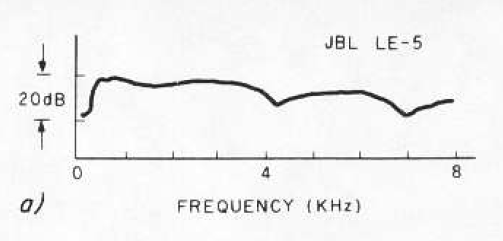
It too, has a dip near 4kHz - which Edgar later describes can be reduced using Scotchbrite pads around the throat. But the response is not unlike what I measured, given Edgar's horn is made of plywood and mine is made of foam core and caulking. Is this a "poor design"?
The 5MR450NDY is also a mid driver that happens to have extension up to 15kHz. So I designed a tractrix around what I thought would be a good throat for the 5MR450NDY using Volvotreter's (Ed Forker) tractrix horn spreadsheet: http://volvotreter.de/downloads/tractrix_v1.3a.xls.zip
I followed the horn profile quite closely as I used 3d CAD software to unroll the tractrix curved panels to a flat using sheet metal design methodologies. The profile I sim'd in Akabak, is the profile I built within a few mm.
Now, when folks use this tractrix horn with a midrange driver, they will typically have a low pass filter to keep it that, a midrange... I just happen to let it run open-ended on top. Now, to keep referring to this tractrix horn as a bad design, a poor performing horn, etc. is that true? Had I applied a 4.5kHz low pass filter on this, no one would call it a poorly performing horn. With the new panel damping used, the vibrations are well under control and the harmonic distortion is remarkably low. I ran it at a pretty loud level, as much as my ears could take as I did not have earplugs on hand. Here is HD at 98dB (2m) which is 104 dB at 1m (mic clips at anything higher than 105dB).
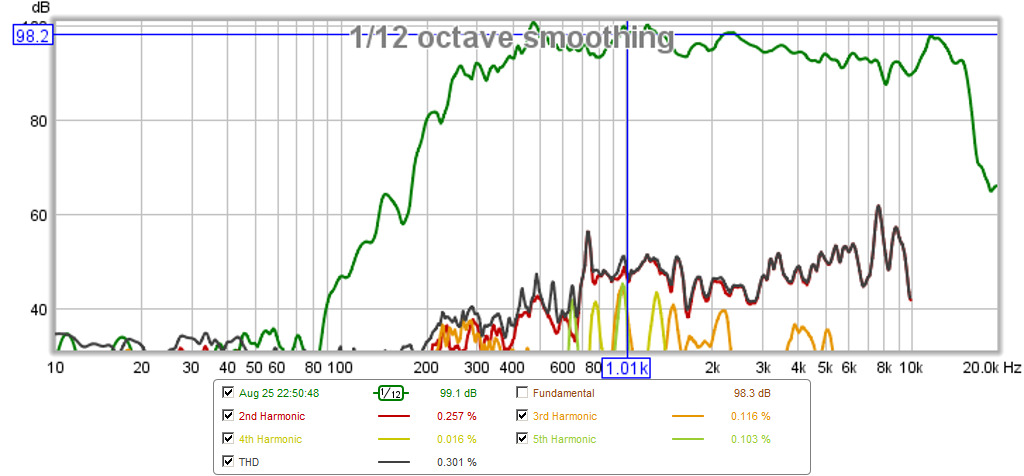
Here is a study of the HD components at 98dB with a 1kHz sine input and RTA just so you can see how poorly performing this horn is:
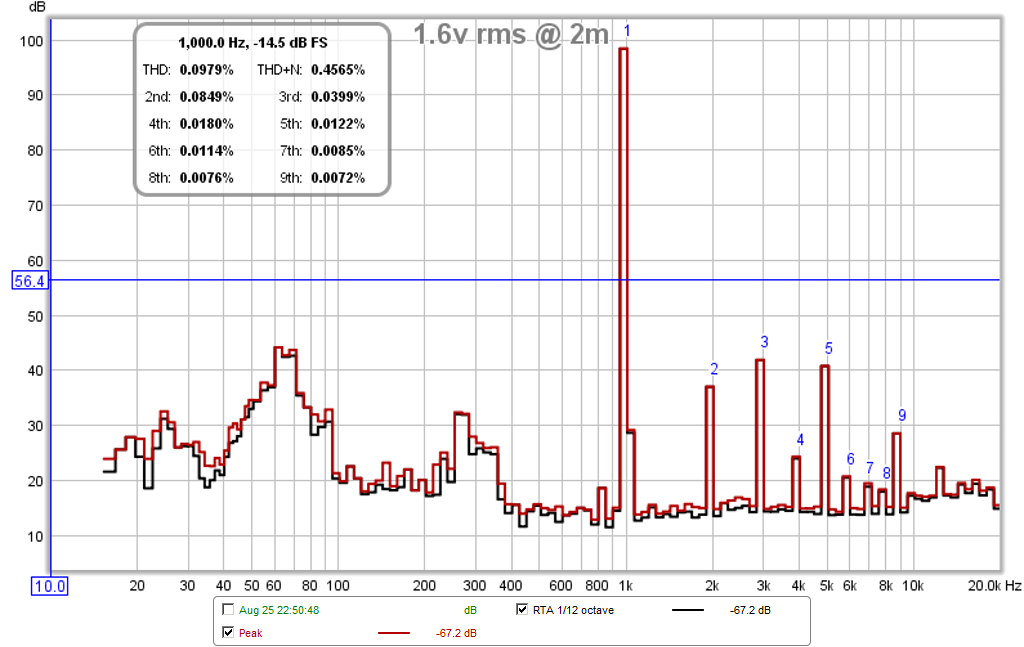
And here is the polar response measured with the new panel damping scheme:
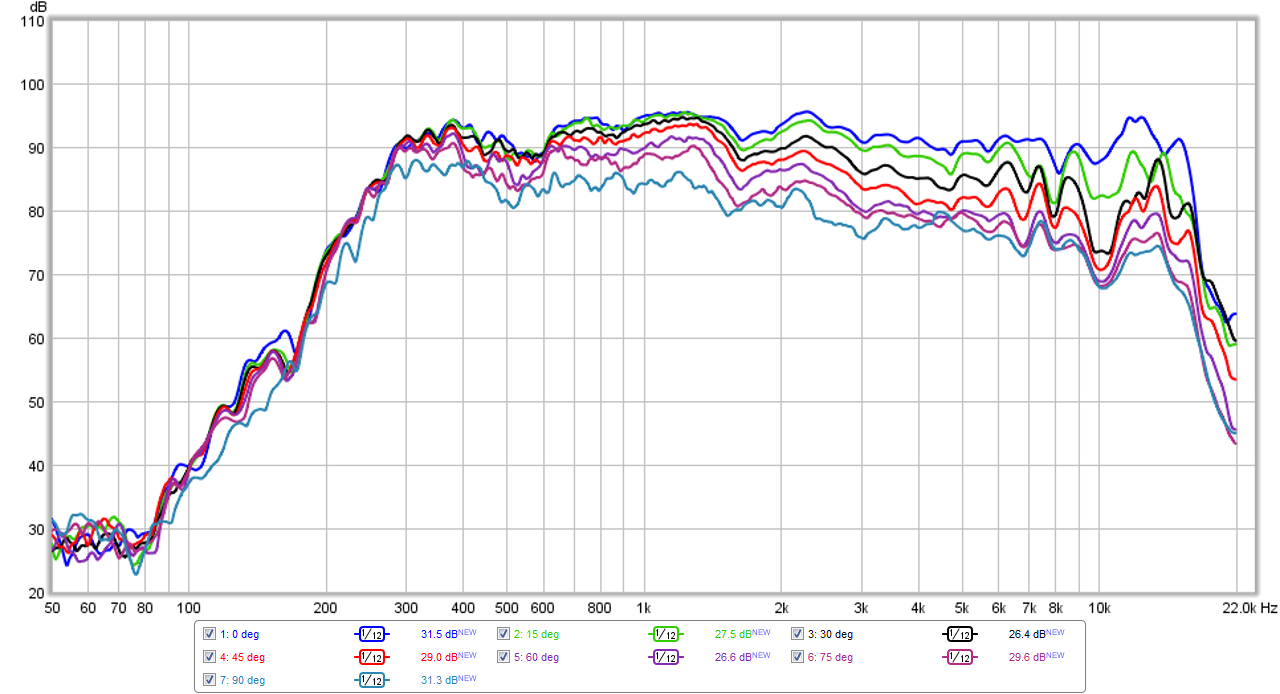
Here is the raw response vs the EQ'd response (with 75Hz HPF and 250Hz HPF):
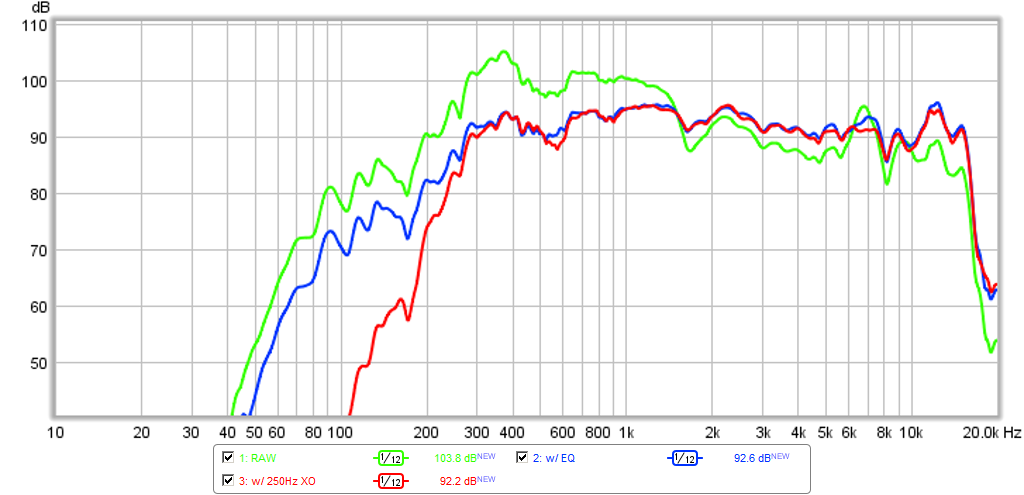
And here is the excessively heavy DSP EQ that is being applied:
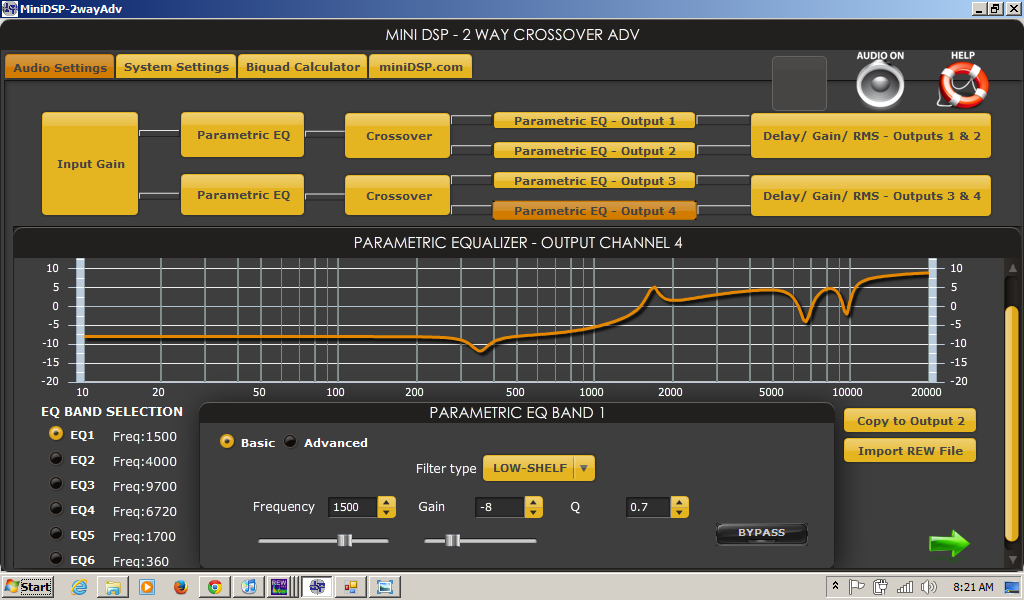
I have laid it all on the table so folks can decide for themselves if this is the sort of horn they may want to try. But to dismiss it as a "bad design" isn't right as it is a 175Hz tractrix design per equations in the Ed Forker spreadsheet, which I assume, are good. Maybe not low-passing it at 1.4kHz or so is "bad" but that seems to allow the horn to reach 15kHz, and do it with acceptable low distortion levels.

It too, has a dip near 4kHz - which Edgar later describes can be reduced using Scotchbrite pads around the throat. But the response is not unlike what I measured, given Edgar's horn is made of plywood and mine is made of foam core and caulking. Is this a "poor design"?
The 5MR450NDY is also a mid driver that happens to have extension up to 15kHz. So I designed a tractrix around what I thought would be a good throat for the 5MR450NDY using Volvotreter's (Ed Forker) tractrix horn spreadsheet: http://volvotreter.de/downloads/tractrix_v1.3a.xls.zip
I followed the horn profile quite closely as I used 3d CAD software to unroll the tractrix curved panels to a flat using sheet metal design methodologies. The profile I sim'd in Akabak, is the profile I built within a few mm.
Now, when folks use this tractrix horn with a midrange driver, they will typically have a low pass filter to keep it that, a midrange... I just happen to let it run open-ended on top. Now, to keep referring to this tractrix horn as a bad design, a poor performing horn, etc. is that true? Had I applied a 4.5kHz low pass filter on this, no one would call it a poorly performing horn. With the new panel damping used, the vibrations are well under control and the harmonic distortion is remarkably low. I ran it at a pretty loud level, as much as my ears could take as I did not have earplugs on hand. Here is HD at 98dB (2m) which is 104 dB at 1m (mic clips at anything higher than 105dB).

Here is a study of the HD components at 98dB with a 1kHz sine input and RTA just so you can see how poorly performing this horn is:

And here is the polar response measured with the new panel damping scheme:

Here is the raw response vs the EQ'd response (with 75Hz HPF and 250Hz HPF):

And here is the excessively heavy DSP EQ that is being applied:

I have laid it all on the table so folks can decide for themselves if this is the sort of horn they may want to try. But to dismiss it as a "bad design" isn't right as it is a 175Hz tractrix design per equations in the Ed Forker spreadsheet, which I assume, are good. Maybe not low-passing it at 1.4kHz or so is "bad" but that seems to allow the horn to reach 15kHz, and do it with acceptable low distortion levels.
Attachments
Last edited:
Hmm, it's funny. There are a lot of people dismissing something that is not done in a 100% correct way. However I have found that some people praise something to hell and back in quadruple. And I've found it disgusting…..go figure?
I can understand JLH's stance that people who tries xrk's horn and find it bad could undermine the horn's reputation. But please, it is not the world peace that is at stake. On the contrary, this can be the beginning of someone's love affair with horns also…..
I find xrk's efforts interesting, especially when backed up with measurements!
When it comes to DSP, I have bought these toys in multitude lately for my ob speaker. So far, I have learned more in the last month than the last 10 years.
It's also funny but I think it's the same as with the beaten-to-death-debate of tone controls. There are bad and good ones. If used with modesty, I can't object to them. I use my DSP's as subtractive and I can't hear any bad effects. I can't grasp it would deteriorate the signal more than inductors and cap's?
As long as I can't hear it, you folks with golden ears are pitied in that case;o)
Keep it up xrk!
I can understand JLH's stance that people who tries xrk's horn and find it bad could undermine the horn's reputation. But please, it is not the world peace that is at stake. On the contrary, this can be the beginning of someone's love affair with horns also…..
I find xrk's efforts interesting, especially when backed up with measurements!
When it comes to DSP, I have bought these toys in multitude lately for my ob speaker. So far, I have learned more in the last month than the last 10 years.
It's also funny but I think it's the same as with the beaten-to-death-debate of tone controls. There are bad and good ones. If used with modesty, I can't object to them. I use my DSP's as subtractive and I can't hear any bad effects. I can't grasp it would deteriorate the signal more than inductors and cap's?
As long as I can't hear it, you folks with golden ears are pitied in that case;o)
Keep it up xrk!
Last edited:
In light of the low distortion figures at reasonable home listening levels, I certainly would not dismiss it as a bad design, and the use of DSP to flatten loudspeaker response is really is of no consequence, passive EQ/crossovers or DSP can be used to achieve the same ends, though DSP is far easier to implement.Now, when folks use this tractrix horn with a midrange driver, they will typically have a low pass filter to keep it that, a midrange... I just happen to let it run open-ended on top. Now, to keep referring to this tractrix horn as a bad design, a poor performing horn, etc. is that true? Here is HD at 98dB (2m) which is 104 dB at 1m (mic clips at anything higher than 105dB).
I have laid it all on the table so folks can decide for themselves if this is the sort of horn they may want to try. But to dismiss it as a "bad design" isn't right as it is a 175Hz tractrix design per equations in the Ed Forker spreadsheet, which I assume, are good. Maybe not low-passing it at 1.4kHz or so is "bad" but that seems to allow the horn to reach 15kHz, and do it with acceptable low distortion levels.
However, this thread is "Suitable midrange cone for bandpass mid in Unity horn".
A Unity horn uses a conical horn for a variety of reasons- constant directivity, the ability to load multiple drivers at various places in the horn to combine in "unity".
Although your wide range Tractrix horn is interesting, it does not seem to be relevant to this thread, other than the driver you chose could be useful in a Unity design.
Art
An externally hosted image should be here but it was not working when we last tested it.

EAW does something like that with their Anya array.
Details are in their patents. The holes are a fibonacci sequence, similar to the second picture above.
http://www.sanecore.cn/sanecore/files/psecond/EAW_anya-photos.jpg
Here's a link to the pic; it's huge and you can't see the detail in the forum, easier to simply download it.

When I used a LeCleach horn for a Synergy horn, I ran into a massive dip due to the reflection off of the midrange ports. I used four symmetrical holes, located about 3.5" from the throat. I think the dip is caused by the size of the holes, the location of the holes, and the depth of the holes.
We can modify all of those variables, but those modifications all have an impact. If you make the holes smaller it changes the response and could limit output. Making the holes shallower is generally a good idea. I think that 'randomizing' the hole locations is an attractive option, since I would expect it to make the dip wider but shallower, which is easier to EQ away.


This issue is seen in the Danley horns too; the ones with wider coverage have smoother response at the crossover points. It's a tricky problem, because I definitely think there are some advantages to a narrower coverage angle. (LeCleach sounds really transparent, but has narrower coverage.)
An externally hosted image should be here but it was not working when we last tested it.
PK Sound out of Canada just debuted their new array, which is Synergy Horn-ish. (Like the Danley Synergy and the EAW Anya and the VTC Paraline it has a compression driver and midranges all on a single waveguide, with a coupling chamber to reduce the apparent size of the midrange units.)
Patrick, do you know whether those dips in frequency response because of the holes in the walls of Synergy horns are present at all coverage angles of those horns? What I mean, are they independent of whether you are 0 degree from axis, 30 or 45? Will just a simple EQ consistently remove them? I remember Tom Danley showing that with FIR filters one could linearise Synergy horns so that their impulse is perfect, but afaik it only showed the result from one microphone position.
Are there some ways to remove the effect of those wall taps in the acoustic domain? I wonder whether covering the wall of the horn with a sheet of cloth, perhaps only acoustically transparent from say 2kHz, will do it. Or stuffing the taps with reticulated foam. Probably not, because otherwise it would have already been done, but I am curious how this all works.
xrk971, please, if that is possible, could you show the impulse response? I think it will be interesting to see what is happenning with HF in time-domain.
All, there was an interesting topic brought up here by JLH, namely the Doppler distortion in case of excessive EQ. Is there any method to quantify it using REW or some other non-professional software? I could imagine something like modulating 5kHz sinus waves with 500 Hz wave and measuring the error in HF, but I am rather clueless in this.
Are there some ways to remove the effect of those wall taps in the acoustic domain? I wonder whether covering the wall of the horn with a sheet of cloth, perhaps only acoustically transparent from say 2kHz, will do it. Or stuffing the taps with reticulated foam. Probably not, because otherwise it would have already been done, but I am curious how this all works.
xrk971, please, if that is possible, could you show the impulse response? I think it will be interesting to see what is happenning with HF in time-domain.
All, there was an interesting topic brought up here by JLH, namely the Doppler distortion in case of excessive EQ. Is there any method to quantify it using REW or some other non-professional software? I could imagine something like modulating 5kHz sinus waves with 500 Hz wave and measuring the error in HF, but I am rather clueless in this.
Last edited:
xrk971, please, if that is possible, could you show the impulse response? I think it will be interesting to see what is happenning with HF in time-domain.
See here:
http://www.diyaudio.com/forums/full-range/259293-prv-5mr450-ndy-fast-applications-15.html#post4038445
xrk971,
Thanks! It's an interesting measurement. It seems from the impulse response that the equalization successfully removed the lower frequency resonance of the horn, though there is a great deal of cone break-up. Is that noticeable? Do you plan to notch it out with an EQ?
I also wonder just how much HOMs are a factor here.
Thanks! It's an interesting measurement. It seems from the impulse response that the equalization successfully removed the lower frequency resonance of the horn, though there is a great deal of cone break-up. Is that noticeable? Do you plan to notch it out with an EQ?
I also wonder just how much HOMs are a factor here.
PK Sound out of Canada just debuted their new array, which is Synergy Horn-ish. (Like the Danley Synergy and the EAW Anya and the VTC Paraline it has a compression driver and midranges all on a single waveguide, with a coupling chamber to reduce the apparent size of the midrange units.)
It cracks me up how hard the other manufactures are trying to imitate the Synergy horn without violating the patent. This has been a great source of unintentional comedy for me.
All, there was an interesting topic brought up here by JLH, namely the Doppler distortion in case of excessive EQ. Is there any method to quantify it using REW or some other non-professional software? I could imagine something like modulating 5kHz sinus waves with 500 Hz wave and measuring the error in HF, but I am rather clueless in this.
Last edited by kenderes; Today at 06:50 AM.
I think you are referring to inter modulation distortion which results in a beat frequency genrated as difference and sum of two excitation frequencies. That can be done and shows up as expected but hard to tell difference if that is an effect happening on the mic itself as the signal "mixer" or in the speaker. I think Weltersys is correct in saying that the term Doppler distortion is a misnomer - as that is a shift in the frequency of the emitted sound due to the motion of the cone - like how a police siren changes PITCH when approaching listener vs going away from listener. An EQ causes a reduction/increase in amplitude at different frequencies - I do not know how that changes the gross speed of the cone motion in a reference inertial frame to cause a shift in pitch to an observer as described by the Doppler equation.
This is one of the primary reasons why a large group of people were so willing to commission a special order of the discontinued Fane Studio 8M. There is no substitute for proper horn design and careful driver selection.
John,
What is the suitable horn for Fane Studio 8M and over what frequency range
will it work? I know that you made some horns for Studio 8M. I have a pair of these drivers.
xrk971,
Thanks! It's an interesting measurement. It seems from the impulse response that the equalization successfully removed the lower frequency resonance of the horn, though there is a great deal of cone break-up. Is that noticeable? Do you plan to notch it out with an EQ?
I also wonder just how much HOMs are a factor here.
I am doing a study of this driver back in the Nautaloss sealed spiral transmission line to see this effect. It appears that at least from an IR standpoint, these oacillations are driver related and can be almost completely removed via notches in EQ around 9 to 12khz. More details will be posted in the 5MR450NDY thread.
- Home
- Loudspeakers
- Multi-Way
- Suitable midrange cone, for bandpass mid in Unity horn.
